Study: Army Corps of Engineers Release Ways to Keep Asian Carp Out of Great Lakes
Plans to stop the invasive fish are costly, and most take more than 10 years to complete.
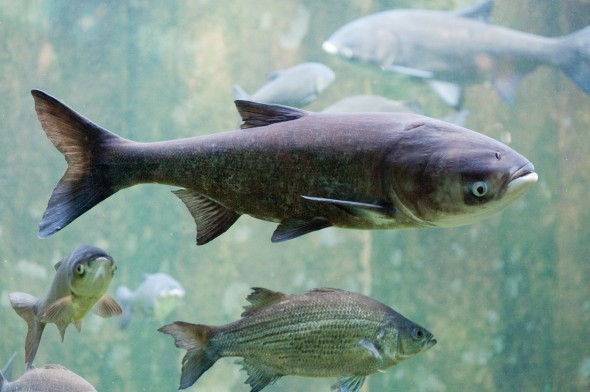
By Codi Yeager-Kozacek
Circle of Blue
It will take at least 25 years and more than $US 15 billion to physically separate the Great Lakes and Mississippi River basins in Chicago, according to a study that was released last Monday by the United States Army Corps of Engineers. The study analyzed eight plans aimed at keeping invasive aquatic species from moving between the basins and causing economic and environmental harm.
The Great Lakes and Mississippi River Interbasin Study (GLMRIS), ordered by Congress in 2007, focused on stopping 13 aquatic species that are most likely to transfer between the basins and become invasive. The two basins, once naturally separated, were connected more than a century ago by a network of rivers and canals in Chicago known as the Chicago Area Waterway System (CAWS). The CAWS was built to facilitate shipping and allow Chicago’s wastewater to flow into the Mississippi River Basin, away from the city’s Lake Michigan drinking water source. However, the introduction of non-native, invasive species in both water basins—GLMRIS identified more than 200—has led to calls for restoring the historical hydrological separation. The most urgent request for federal action comes from the Great Lakes states, where the region’s $US 7 billion sport-fishing industry could take a hit if Asian carp become established in the lakes and outcompete native fish.
–Joel Brammeier, president & CEO
Alliance for the Great Lakes
GLMRIS presented two plans for restoring a complete physical separation between the water basins, which it concluded is the most effective way to stop the advance of Asian carp and other invasive species. It did not, however, recommend either of the plans over the other six options—including a baseline option that maintains current federal actions, an option to step up efforts that do not require infrastructure, and four hybrid options that involve a combination of barriers, locks, and other controls. The price tag for these plans ranges from $US 68 million to more than $US 18 billion, with the options for complete hydrological separation starting at more than $US 15 billion. Furthermore, all of the plans that require additional infrastructure take at least 10 years to complete, and hydrological separation will take as many as 25 years to be fully implemented.
Questions About Cost
The costs outlined in GLMRIS have become a sticking point for both opponents and proponents of hydrological separation.
“We believe it is clear from the GLMRIS report that one of the alternatives, physical separation, is neither economically feasible nor will it be effective at eliminating all identified pathways for the spread of invasive species, including Asian carp,” said Tom Allegretti, president and CEO of American Waterways Operators, in a statement released in response to GLMRIS. AWO represents the interests of the tugboat, towboat and barge industry. GLMRIS estimated that hdyrological separation could cost the commercial cargo industry between $US 210 million and $US 250 million annually, depending on the option implemented.
However, Joel Brammeier, president and CEO of the Alliance for the Great Lakes, said that the costs given in the GLMRIS report appear to cover much more than is absolutely necessary for creating hydrological separation. A study by the Great Lakes Commission (GLC) and the Great Lakes and St. Lawrence Cities released in 2012 analyzed plans for hydrological separation that ranged in cost from $US 3.26 billion to $US 9.54 billion.
“[GLMRIS] includes some costs dealing with extreme rain events and sediments that really go beyond anything anyone expected,” he told Circle of Blue. “Before anyone can say anything intelligent about the price tag, we have to figure out why the Corps has included these tremendous costs for things that weren’t a priority yesterday.”
–Duane Chapman, research fisheries biologist
USGS
For example, nearly $US 13 billion of the estimated $US 15.5 billion required to implement a physical separation of the basins in the “Mid-System” plan would be spent on water quality mitigation measures. These include tunnels to re-route wastewater outfalls so that they continue to discharge into the Mississippi River basin rather than Lake Michigan, but also sediment remediation for the Chicago and Calumet rivers. The plan also includes flood mitigation measures that could withstand a 500-year storm event, costing $US 24 million.
“The clean-up of the Chicago River is both a legal and ethical obligation regardless of the presence of Asian carp, and people have been working on stopping sewage overflows and contamination irrespective of what happens with hydrological separation,” Brammeier said. “We want to know why 100 percent of the costs of those activities are now being lumped into these Corps estimates.”
According to GLMRIS, the mitigation measures are necessary to avoid adverse effects on the users of Lake Michigan and the CAWS. Furthermore, they must be implemented before any of the physical barriers can be installed—meaning that the risk of an Asian carp invasion through the CAWS is not reduced for 25 years.
A 25-Year Timeline
The current risk of Asian carp getting through the electric barriers in the CAWS in great enough numbers to establish a reproducing population in Lake Michigan is low, GLMRIS found. Populations of silver and bighead carp have officially only reached Dresden Island Pool on the Illinois River, 29 kilometers (18 miles) from the electric dispersal barriers and 89 kilometers (55 miles) from Lake Michigan. Therefore, GLMRIS researchers concluded that it is unlikely that many fish will be present near the barriers, and that those that are present will be repelled by the barriers. After 25 years, however, the populations are expected to have moved up the river to the extent that the risk of an invasion into Lake Michigan becomes medium.
“In my opinion, the carp aren’t going to be getting through that electric barrier—not that it’s impossible—but with a reasonable amount of uncertainty, it’s unlikely the carp will get through the barrier at any time in the near future,” Duane Chapman told Circle of Blue. Chapman is a research fisheries biologist at the United States Geological Survey’s Columbia Environmental Research Center and a leading expert on Asian carp. “I agree with that assessment.”
–Greg Zoeller, attorney general
State of Indiana
Nonetheless, state officials and conservation organizations in the Great Lakes region are dissatisfied with the pace of action set forth by GLMRIS.
“Anyone who is concerned about the Asian carp problem knows that waiting 25 years and then flipping a switch is not an acceptable action,” Brammeier said. “That was the biggest complaint I’ve seen coming out of this is that the timeline doesn’t tell us how we are going to get better protection for the Great Lakes this year or next year. That simply isn’t an acceptable answer.”
At the first public hearing about the GLMRIS report, held last Thursday in Chicago, there were also calls for more action to address the problems created by existing Asian carp populations.
“We waited for the past 7 years while Congress was authorizing this study—a 7-year-wait when we can see the problems that are currently existing getting worse,” Greg Zoeller, Indiana’s Attorney General, said while speaking at the hearing. “So now the report comes out and it doesn’t address problems in the Wabash River and other waterways that are overrun with Asian carp. Where can we turn for help?”
He added that expending resources now on control measures in places like the Wabash River could prove extremely useful if the carp do ever reach the Great Lakes, calling it “good practice.”
Any further action by the Army Corps of Engineers will require congressional approval, and would likely involve further studies before any plan is implemented. The timelines included for plans in the GLMRIS report start in 2017.
The Plans
Plan 1: Baseline Option
Description: No new actions to stop invasive species. Continue operation of electrical barriers in the Chicago Area Waterways System (CAWS), commercial harvesting of Asian carp, and research of invasive species.
Cost: $US 0
Timeline: 0 years
Invasive Species Risk Reduced For: None.
Plan 2: Nonstructural Control Technologies
Description: In addition to actions outlined in Plan 1, includes outreach and education about invasive species, the use of chemicals to control invasive species, the use of physical removal methods, and improved cleaning and inspection of watercraft.
Cost: $US 68,000,000
Timeline: 0 years
Invasive Species Risk Reduced For: Grass kelp, reed sweetgrass, tubenose goby.
Plan 3: Mid-System Control Technologies Without a Buffer Zone
Description: In addition to actions outlined in Plans 1 and 2, includes the construction of two new locks — one at Stickney and one at Alsip — to control water flowing through the CAWS. Each lock would include electrical barriers and treatment plants to flush the locks. This plan also requires the construction of three reservoirs and conveyance tunnels to prevent flooding.
Cost: $US 15,543,000,000 (does not include annual costs)
Timeline: 25 years
Invasive Species Risk Reduced For: Bighead carp, silver carp, bloody red shrimp, grass kelp, reed sweetgrass, ruffe, threespine stickleback, tubenose goby.
Plan 4: Control Technology Alternative with a Buffer Zone
Description: In addition to actions outlined in Plans 1 and 2, creates a “buffer zone” within the CAWS between the Lake Michigan lakefront and Brandon Road. Three new locks equipped with electrical barriers, and three new treatment plants would control water flowing into the buffer zone, as well as three new screened sluice gates and two physical barriers. Two reservoirs and a conveyance tunnel would also be constructed to prevent flooding.
Cost: $US 7,806,000,000 (does not include annual costs)
Timeline: 10 years
Invasive Species Risk Reduced For: Bighead carp, silver carp, bloody red shrimp, grass kelp, reed sweetgrass, ruffe, threespine stickleback, tubenose goby.
Plan 5: Lakefront Hydrologic Separation
Description: In addition to actions outlined in Plan 2, includes the construction of four physical barriers within the CAWS and three treatment plants to improve water quality and water movement. Two reservoirs and four conveyance tunnels would also be constructed to prevent flooding.
Cost: $US 18,389,000,000 (does not include annual costs)
Timeline: 25 years.
Invasive Species Risk Reduced For: Scud, bighead carp, silver carp, bloody red shrimp, a Diatom, fishhook waterflea, grass kelp, red algae, reed sweetgrass, ruffe, threespine stickleback, tubenose goby, VHSv.
Plan 6: Mid-System Hydrologic Separation
Description: In addition to actions outlined in Plan 2, includes the construction of two physical barriers and treatment plants within the CAWS. The barriers would be placed closer to the location where natural separation historically occurred than the location of physical barriers in Plan 5. Also includes the construction of one reservoir for flood mitigation, as well as new reservoirs and tunnels to prevent sewer outfalls from flowing into Lake Michigan.
Cost: $US 15,512,000,000 (does not include annual costs)
Timeline: 25 years
Invasive Species Risk Reduced For: Scud, bighead carp, silver carp, bloody red shrimp, a Diatom, fishhook waterflea, grass kelp, red algae, reed sweetgrass, ruffe, threespine stickleback, tubenose goby, VHSv.
Plan 7: Mid-System Hydrologic Separation Cal-Sag Open Control Technologies with a Buffer Zone
Description: In addition to actions outlined in Plan 2, includes the construction of three physical barriers to create hydrological separation on four of five possible pathways. Two locks with electrical barriers, as well as one screened sluice gate and two treatment plants would create a “buffer zone” along the fifth possible pathway. The plan requires two reservoirs and a conveyance tunnel for flood mitigation, along with the relocation of tunnels and sewer outfalls to maintain water quality.
Cost: $US 15,097,000,000 (does not include annual costs)
Timeline: 25 years
Invasive Species Risk Reduced For: Bighead carp, silver carp, bloody red shrimp, grass kelp, reed sweetgrass, ruffe, threespine stickleback, tubenose goby.
Plan 8: Mid-System Hydrologic Separation CSSC Open Control Technologies with a Buffer Zone
Description: In addition to actions outlined in Plan 2, includes the construction of one physical barrier to create hydrological separation on three of five possible pathways. Two locks with electrical barriers, as well as two screened sluice gates and three treatment plants would create “buffer zones” along the remaining two pathways. The plan requires one new reservoir for flood mitigation, in addition to the relocation of tunnels and sewer outfalls to maintain water quality.
Cost: $US 8,333,000,000 (does not include annual costs)
Timeline: 25 years
Invasive Species Risk Reduced For: Bighead carp, silver carp, bloody red shrimp, grass kelp, reed sweetgrass, ruffe, threespine stickleback, tubenose goby.
Read more: GLMRIS
A news correspondent for Circle of Blue based out of Hawaii. She writes The Stream, Circle of Blue’s daily digest of international water news trends. Her interests include food security, ecology and the Great Lakes.
Contact Codi Kozacek

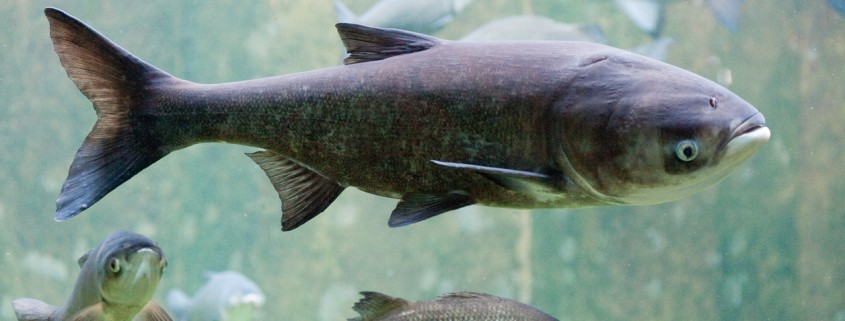


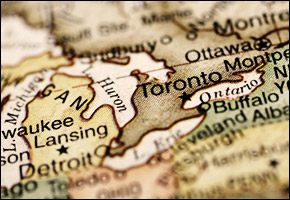
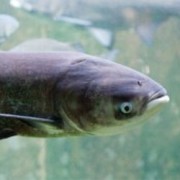
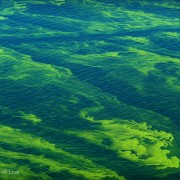



Leave a Reply
Want to join the discussion?Feel free to contribute!